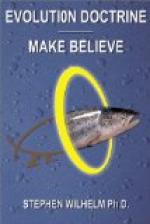Mainly through the influence of the renowned English man of science, Charles Lyell, the students of the earth came to the conclusion that its manifold structures had developed by a slow and orderly process that was entirely natural; for they found no evidence of any sudden and drastic world-wide remodeling such as that postulated by the Cuvierian hypothesis of catastrophe. The battle waged for many years; but now naturalists believe that the forces, of nature, whose workings may be seen on all sides at the present time, have reconstructed the continents and ocean beds in the past in the same way that they work to-day. The long name of “uniformitarianism” is given to Lyell’s doctrine, which has exerted an influence upon knowledge far outside the department of geology. Darwin tells us how much he himself was impressed by it, and how it led him to study the factors at work upon organic things to see if he could discern evidence of a biological uniformitarianism, according to which the past history of living things might be interpreted through an understanding of their present lives.
* * * * *
What, now, are the reasons why the palaeontological evidence is not complete and why it cannot be? In the first place the seeker after fossil remains finds about three fifths of the earth’s surface under water so that he cannot explore vast areas of the present ocean beds which were formerly dry land and the homes of now extinct animals. Thus the field of investigation is seriously restricted at




